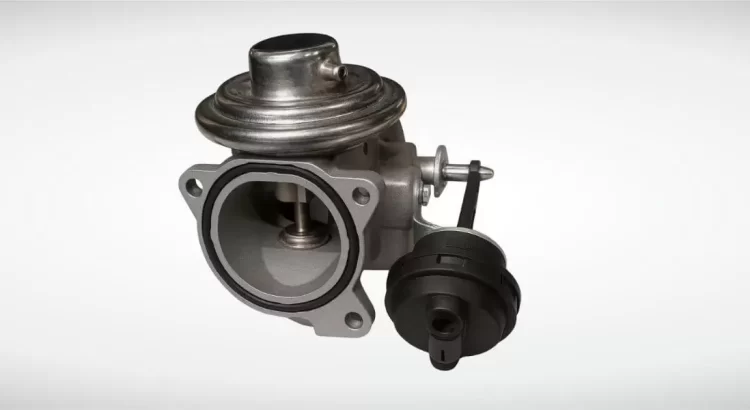The EGR valve is one of the most important parts of a car’s emission control system.
Its function is simple but essential: to reduce the emission of polluting gases and help the engine run more efficiently.
In this article, learn what this valve is, how it works, the main symptoms of malfunction, and what to do in case of clogging.
What Is The EGR Valve?
The acronym EGR stands for Exhaust Gas Recirculation. In other words, the EGR valve is a component installed in the engine’s exhaust and intake system, responsible for reintroducing part of the exhaust gases into the intake manifold.
This reduces the combustion temperature and, consequently, the production of nitrogen oxides (NOx), one of the most polluting gases.
What Does An EGR Valve Do?
The main function of the EGR valve is to reduce pollutant emissions and improve engine efficiency.
When the engine reaches a high temperature, the valve opens, allowing some of the burned gases to re-enter the combustion chamber.
This process helps to:
- Reduce NOx emissions;
- Control the internal temperature of the engine;
- Increase the durability of the exhaust system and catalytic converter.
Where Is The EGR Valve Located?
As a general rule, it is located between the exhaust manifold and the intake manifold.
In diesel engines, it is usually located at the top of the engine, next to the turbo.
In gasoline engines, it may be integrated into the throttle body or near the air intake.
What Are The Types Of EGR Valves?
There are two main types of EGR valves:
- Pneumatic: controlled by the engine’s vacuum pressure. It is more common in older cars;
- Electronic: managed by the engine control unit, using temperature and pressure sensors. It is present in most modern cars.
As a general rule, electronic valves offer greater precision, but are also more sensitive to residue buildup.
What Happens If You Remove The EGR Valve?
According to the Highway Code and European environmental standards, altering the emissions system constitutes a serious offense.
In the short term, the engine may seem more “loose,” but in the long term, it increases internal wear and emissions.
How To Know If The EGR Valve Is Bypassed?
If the EGR valve is bypassed, the car may exhibit:
- Malfunction light even with excessive smoke;
- Abnormal emission values during inspection;
- Failures in electronic diagnostics (no response from the valve).
The only sure way to confirm this is by reading the parameters in the control unit.

What Happens When Your EGR Valve Goes Bad?
A damaged and/or clogged EGR valve can cause several problems with engine performance.
The most common symptoms of a clogged EGR valve are:
- Loss of power;
- Black smoke from the exhaust;
- Increased fuel consumption;
- Irregular running or acceleration failures;
- Engine malfunction light on the dashboard (check engine).
Ignoring these signs can damage other components, such as the turbo or catalytic converter.
How To Know If The EGR Valve Is Working?
You can check the operation of this valve in two ways:
- With an OBD-II scanner: the diagnosis shows if there are faults in the EGR circuit;
- Visually: if the valve is stuck open or closed, it is a sign of malfunction.
Alternatively, a mechanic can also measure the gas flow and confirm if there is a blockage.
Can I Drive A Car With A Bad EGR Valve?
No. A faulty EGR valve can lead to:
- Engine overheating;
- Damage to the turbo;
- Polluting emissions above the permitted level;
- Higher fuel consumption.
Ideally, you should replace or clean the EGR valve as soon as you detect symptoms.
How Should I Clean The EGR Valve?
This EGR valve should be cleaned when the engine is cold, using a spray or product specifically designed for cleaning this component.
The general process is as follows:
- Disconnect the battery and remove the valve;
- Apply the cleaning product to areas with soot residue;
- Leave it to work for a few minutes;
- Clean carefully with a cloth and reinstall.
In cases of severe clogging, ultrasonic cleaning at a specialized mechanic’s workshop is recommended.
How Much Does It Cost To Clean The EGR Valve?
The price of cleaning the EGR valve varies, on average, from tens to hundreds of euros, depending on the type of engine and the method used (manual or ultrasonic).
This is an investment that can prevent more expensive replacements in the future.
How Much Does It Cost To Replace An EGR?
The price of an EGR valve can start at tens of euros. If the entire system needs to be replaced, the cost can run into hundreds of euros.
As you can see, keeping this part clean and in good condition improves performance, reduces fuel consumption, and prevents more expensive breakdowns.
If you suspect a problem, consult a professional as soon as possible.
Want to know more about the automotive world? Then follow us on Facebook and keep up with all the content we share daily.



